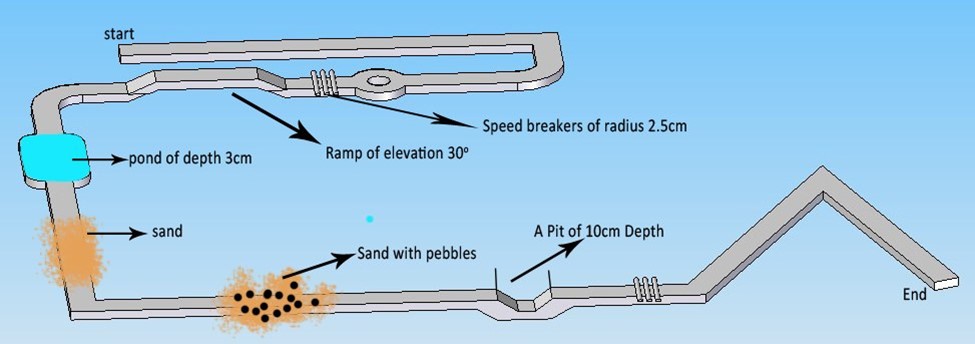Problem Statement
Design a wired/wireless manually controlled robot which should be able to travel on both land, water, etc. The robot that traverses all the hurdles and completes the track in minimum amount of time is declared as the ‘DEATH RACE CHAMPION’.
Bot Specifications
- The dimensions of the vehicle must be within (40x40x40) cm.
- The robot can be wired/ wireless.
- In case of wired control, the wires should be slack all the time.
- In case of wireless control, the RC should have two remote control circuits (or dual frequency remote control circuit/Bluetooth) which can be switched to either of the frequency before the event.
- The power supply for the vehicle should not exceed 12V DC between any two points in the circuit at any given time.
- Use of readymade chassis/ RC Car is not allowed.
- Use of IC engine or compressor is not allowed. All the robots must depend only on motors for their propulsion and control.
- The body of the vehicle must be covered, to avoid any entanglement between two competing robots.
- Damaging the wires of opponent will lead to disqualification.
Arena Specifications
The robot has to traverse through a rough terrain of width 1.2m which is surrounded by a barrier of height 10cm.
The arena has 6 types of regions
Region 1:
The robot has to move across a series of speed breakers each of radius 2.5cm.
Region 2:
The robot has to move through a pit of depth 10cm.
Region 3:
A small portion of the track is filled with sand (with depth 2cm) on which the robot has to traverse.
Region 4:
The track is elevated with an inclination of 30 degrees in this part.
Region 5:
This region is a graveled path
Region 6:
In this region, the robot has to travel through a damp area, filled with water with a depth of 3cm.
There may be few water fountains on the arena, where water may spill on your robot. Watch out few surprise regions.
Rules
- Participants should posses a valid identity card from their respective Institutions
- Teams must start their Robots from the starting line only after a signal is given by the Referee
- The timer starts immediately after the signal is given
- Number of participants per team should not exceed 4
- Bot should always remain inside the track. If the bot leaves the track at any point of the time during the race or bot becomes immobile, it will be considered as a “PIT FALL” which is an opportunity to repair or relocate the bot
- Each pit fall spans for 1 minute
- First three pit fall are considered to be penalty free
- Only two person from a team is allowed to manipulate the bot during a pit fall
- One hour before the event bot must go through specification check
- Misbehavior of a participant will lead to disqualification
- If there are less than 5 teams registered , event will be cancelled.
- ACROM/IEEE RAS is not responsible for any damage to the bot occurred on or off the event
- If special circumstances, such as unforeseen problems or capabilities of a robot occur, rules may be modified by the referee.
- Referee’s Decision will be final
Judging Criteria
- The time taken to complete the whole track is solely considered. The robot which completes the track in least time is declared as the winner.
- Wireless controlled robots will have some advantage in the track.
- In case of a tie then other factors such as no of pitfalls are considered.
- Referee’s decision will be final.
Sample Track
Event Coordinators
Phani: +91 8978474413
Chitra
